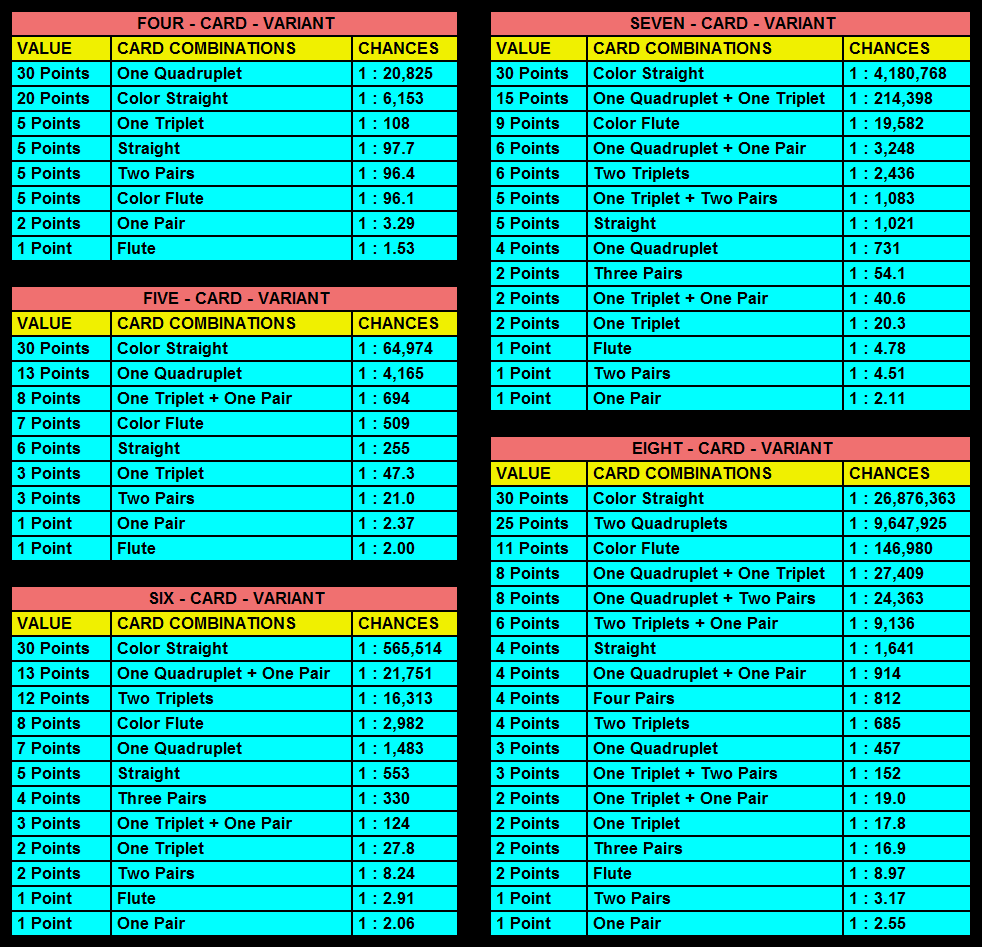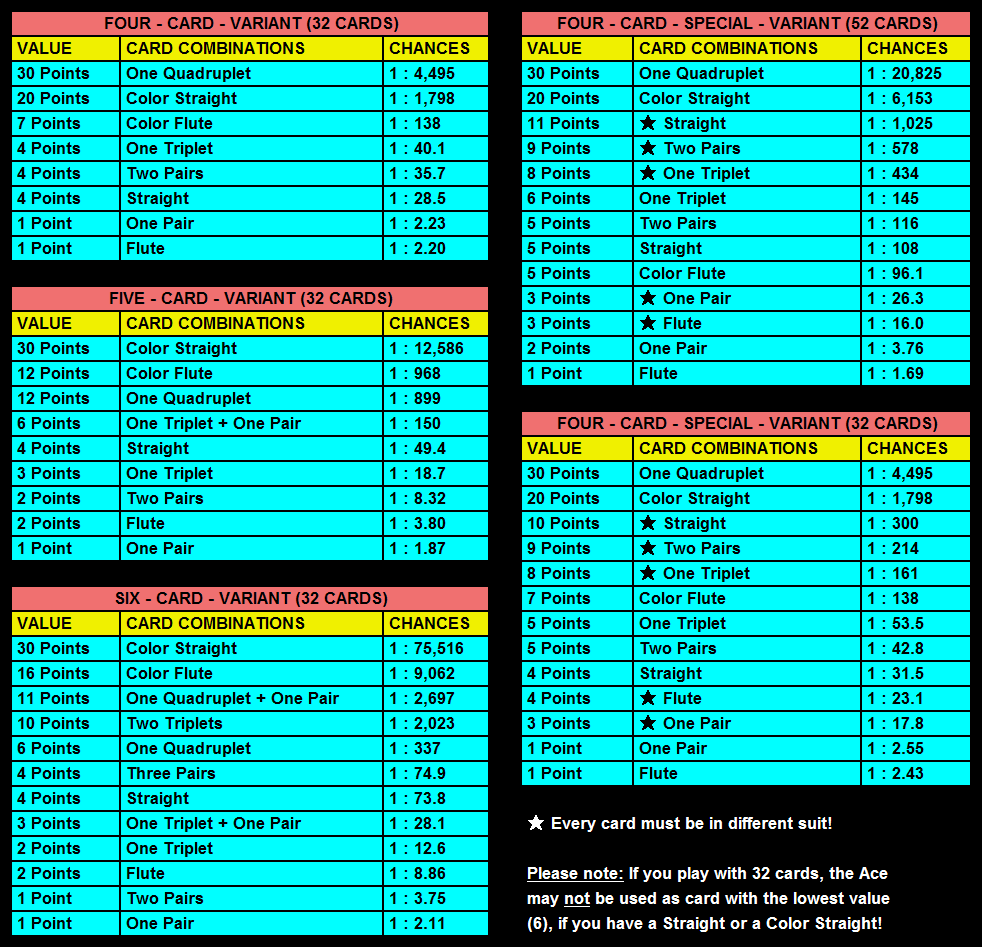

 Rules for playing Poker Deluxe (game variant of Poker)
Rules for playing Poker Deluxe (game variant of Poker)
1. Game preparation and game description
To play this game, you need a pack of 52 playing cards, playing chips and a container for the storage of the playing chips when buying cards. The objective of the game is to achieve the best possible combination of cards. With those cards one wants to receive playing chips from the other players. The game can be played with four to eight cards. However, the ranking of the card combinations is different depending on the number of cards (see chapter 6). Each player receives 75 monetary units as playing chips (for example, three blue chips with the monetary value of 10, five red chips with the monetary value of 5, six yellow chips with the monetary value of 2 and eight white chips with the monetary value of 1). The ranking of cards, from lowest to highest, is 2, 3, 4, 5, 6, 7, 8, 9, 10, J, Q, K, A. If you have a Straight or a Color Straight, you may also use an ace as card with the lowest value (1). The youngest player is the first dealer. After each game, the cards must be dealt out by the player sitting to the left of the previous dealer. If all players have dealt once, the first round is over. The player who has the most playing chips after a previously defined number of rounds is the overall winner. If a player goes broke before the defined number of rounds are reached, the game is immediately over and the winner is also the player who has the most playing chips at this point.
2. Card combinations
Pairs, Triplets and Quadruplets (combinations with the same card values)
A Pair consists of two cards with the same value (for example two Jacks).
A Triplet consists of three cards with the same value (for example three Queens).
A Quadruplet consists of four cards with the same value (for example all four Kings).
You can also have several card combinations at once (for example "Two Pairs" or "One Triplet + One Pair").
The number of all possible combinations depends on the number of cards you play.
A Triplet consists of three cards with the same value (for example three Queens).
A Quadruplet consists of four cards with the same value (for example all four Kings).
You can also have several card combinations at once (for example "Two Pairs" or "One Triplet + One Pair").
The number of all possible combinations depends on the number of cards you play.
Possibilities with 4 cards:
One Pair / Two Pairs / One Triplet / One Quadruplet
Additional possibilities with 5 cards:
One Triplet + One Pair
Additional possibilities with 6 cards:
Three Pairs / Two Triplets / One Quadruplet + One Pair
Additional possibilities with 7 cards:
One Triplet + Two Pairs / One Quadruplet + One Triplet
Additional possibilities with 8 cards:
Four Pairs / Two Triplets + One Pair / One Quadruplet + Two Pairs / Two Quadruplets
Flute, Color Flute, Straight and Color Straight (combinations with different card values)
A Flute consists only of different card values in any suit.
e.g.: Five of Spades, Seven of Hearts, Ten of Diamonds, Ace of Hearts (with 4 cards)
A Color Flute consists only of different card values in the same suit.
e.g.: Three of Spades, Five of Spades, Eight of Spades, Nine of Spades, Jack of Spades, King of Spades (with 6 cards)
A Straight consists only of consecutive card values in any suit.
e.g.: Eight of Hearts, Nine of Diamonds, Ten of Clubs, Jack of Diamonds, Queen of Spades (with 5 cards)
A Color Straight consists only of consecutive card values in the same suit.
e.g.: Ace of Clubs, Two of Clubs, Three of Clubs, Four of Clubs, Five of Clubs, Six of Clubs, Seven of Clubs (with 7 cards)
e.g.: Five of Spades, Seven of Hearts, Ten of Diamonds, Ace of Hearts (with 4 cards)
A Color Flute consists only of different card values in the same suit.
e.g.: Three of Spades, Five of Spades, Eight of Spades, Nine of Spades, Jack of Spades, King of Spades (with 6 cards)
A Straight consists only of consecutive card values in any suit.
e.g.: Eight of Hearts, Nine of Diamonds, Ten of Clubs, Jack of Diamonds, Queen of Spades (with 5 cards)
A Color Straight consists only of consecutive card values in the same suit.
e.g.: Ace of Clubs, Two of Clubs, Three of Clubs, Four of Clubs, Five of Clubs, Six of Clubs, Seven of Clubs (with 7 cards)
If several players have a flute, a color flute, a straight or a color straight, the highest card wins (then, the second highest card, and so on). If several players have the same combination which contains a quadruplet, the highest quadruplet wins. If several players have the same combination which does not contain a quadruplet, the highest triplet wins. If several players have the same combination which contains only pairs, the highest pair wins (then, the second highest pair, and so on). If all pairs are the same, the highest of the remaining cards wins (then, the second highest card, and so on). If there is an absolute correspondence between several combinations, the youngest player wins.
3. Dealing cards
After the dealer has shuffled the cards, the player to his right must cut some cards from the deck and lay them aside. The dealer takes the remaining cards and puts them on the raised part of the deck. Depending on which game variant was selected, each player receives four to eight cards which must be dealt out one at a time. The players may only pick up their cards, when all the cards have been dealt. After that, each player receives four more cards. However, these cards must stay face down on the table and can be bought later in the course of the game by discarding cards.
4. Buying cards
The player to the left of the dealer may start by buying one of his four cards that are lying face down. To do this, he must discard one of his cards (this card must be placed face down in the middle of the table). After that, he must pay one playing chip (monetary value 1) to the bank. Now, he may add one card from those lying face down to his hand. Similarly, he can also buy the second, the third and the fourth card. However, for the second card he must pay the bank two monetary units, for the third card three monetary units and for the fourth card four monetary units. If he has bought all cards or does not want to buy any more, his left hand neighbor has a turn. However, no player is obliged to buy cards. After each player has had a chance to buy some of his cards face down, the cards must be revealed.
5. Paying out
Each player places his cards face up on the table one by one. Each card combination has a certain point value (see chapter 6). At first, the player with the highest card combination gets all playing chips paid to the bank. After that, he may get the point difference from the other players as playing chips.
Example 1: You play with seven cards. "Player A" has the combination "One Triplet + Two Pairs" (5 points), "Player B" has the combination "One Quadruplet + One Triplet" (15 points) and "Player C" has the combination "One Pair" (1 point). Now, "Player B" receives 10 monetary units from "Player A" and 14 monetary units from "Player C".
Example 2: You play with six cards. "Player A" has the combination "One Triplet" (2 points), "Player B" has the combination "Straight - the highest value is Queen" (5 points) and "Player C" has the combination "Straight - the highest value is Ace" (5 points). Now, "Player C" receives 3 monetary units from "Player A". "Player B" does not pay anything.
6. Comparison of the game variants

7. Game with 32 cards and special variant for playing with 4 cards

8. Game statistics to print out
Poker Deluxe Swap Statistics (52-1) Poker Deluxe Swap Statistics (52-2) Poker Deluxe Swap Statistics (32) Basis of Calculation (Excel)